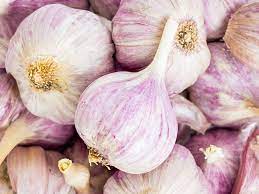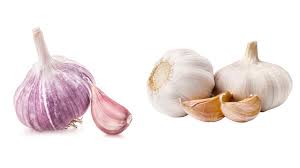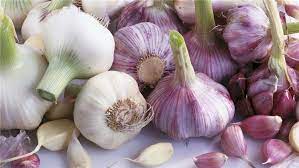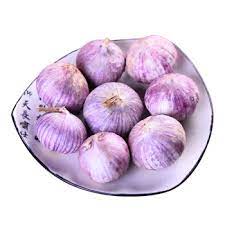Have you seen garlic with purple skin? I often hear the question: why is garlic sometimes purple? Why is the garlic skin purple? What does it mean when garlic is purple? In fact, garlic with purple skin is not bad, but a variety called purple stripe garlic. Although prices are similar, they different in efficacy and flavor.
What is purple garlic?

Purple garlic is one of the hard-necked varieties of garlic with purple stripes on the outer skin. The purple garlic cloves have few but large petals, an intense, spicy flavor, and good quality. In addition, its bulbs have a long storage life and can provide a unique flavor throughout the winter. In the cold northern regions, the traditional planting method has always been spring planting and summer harvest. In this way, the storage is troublesome in winter, but the yield is low. To improve the economic benefits of growing purple garlic, we generally cultivate them through winter. This approach solves the problems of draining, mildew, and heat damage to seeds and significantly increases the yield. If you want to wholesale purple garlic you can contact us.
The origin of purple garlic
Generally speaking, people think that the origin of garlic with purple skin is Central Asia and West Asia. An ancient agricultural village in the Baja Peninsula. This is a dusty, steep, and mountainous place. Since Spanish missionaries first planted it 300 years ago, they have been growing purple garlic here! The Spanish have always liked high-quality wine and garlic with purple skin. They grow organic garlic with purple skin anciently and use naturally generated goat manure to fertilize. Because the purple garlic usually takes a long way to be served after being picked, they bred it into a more intense flavor!
Purple Garlic vs. White Garlic

White garlic
We usually find white garlic in most grocery stores. It is a soft neck garlic variety, which means that the stem does not grow through the center of the bulb. Therefore, the stem at the end of the white garlic always remains soft. This is why traditionally, garlic strings are woven from white garlic.
Purple garlic
The purple garlic is garlic with purple skin, and the color of the inner cloves is the same as that of white garlic. It is a type of hard-necked garlic: a woody stalk grows in the center of each bulb. You may often see purple garlic in some supermarkets, but we usually easier to find it in farmers’ markets.
The difference between purple garlic VS white garlic

Taste
- Purple garlic cloves are medium in size and uniform, with a strong spicy flavor, early ripening, and good quality. Therefore, it is suitable for garlic bulb cultivation.
- White garlic has few large cloves (or a small amount of clamped cloves), thin and white skin, sticky and spicy. In comparison, white garlic juice is more sufficient. In addition, the white garlic plant is tall and hardy, so the growth momentum and adaptability are also strong.
Nutritious value.
Both purple garlic and white garlic contain protein, vitamins, cellulose, phosphorus, iron, calcium, and other mineral nutrients. Although they generally contain similar nutrients, according to modern medical analysis: due to various reasons, purple stripe garlic contains more anthocyanins than white garlic (the most significant effect of anthocyanins is antioxidant). The selenium in white garlic is more abundant than purple stripe garlic to choose from according to our needs.
Antibacterial effect.
The purple stripe garlic is more antibacterial than white garlic. Compared with white garlic, it has a more spicy taste. Researchers found that the content of allicin in purple stripe garlic is relatively higher, so the antibacterial effect is more obvious. This is why when everyone eats raw garlic; Purple stripe garlic is more pungent than white garlic.
Storage environment
- Generally speaking, white garlic has a thinner skin and higher cold resistance, but it also contains more water than purple stripe garlic. Therefore, if you store white garlic, use a plastic bag or a fresh-keeping bag to seal it up, put it in the refrigerator, and keep it sealed at a lower temperature.
- Generally, we place purple stripe garlic in a dry and ventilated place. After the purple stripe garlic is dried in the shade, hang it for storage, and it is not suitable to explore it in the sun.
How to choose purple garlic?

Skin color
Purple stripe garlic with darker skin and more evenly distributed stripes are of better quality. Do not buy it if the skin color is light and the stripes are unevenly distributed.
Appearance
When choosing purple stripe garlic, try to choose a round shape with better wrapping. Do not choose chipped or deformed. Choose the cloves that have obvious arcs, are evenly distributed, and are closely connected. Cloves are big and full, and the quality of this kind of purple stripe garlic is better.
Touch
When selecting purple stripe garlic, please pay attention to its top. Generally, purple stripe garlic will grow new buds from the top. If you find that it has sprouted, it is recommended not to buy it. The sprouting of purple stripe garlic will affect its nutritional content. Put it in your hand and touch it lightly. It is good if you feel the cloves firm, dry, heavy, and firm when held. If the cloves are soft to the touch and dented, the inside of the purple garlic may have begun to deteriorate, so don’t buy it.
Garlic turning purple? Is purple garlic bad?

Many people may mistakenly think that purple garlic is garlic turning purple. So it will be strange: is purple garlic bad? In fact, garlic turning purple is a normal phenomenon and has nothing to do with the purple garlic. And it can still be eaten after garlic turning purple. Then you may ask: why is my garlic purple? This is because garlic contains anthocyanins, water-soluble pigments that can turn garlic cloves into purple or blue under acidic conditions. This is a variable phenomenon, which is more evident for immature garlic. But there may be differences between individual garlic cloves! Sometimes garlic has more blue pigment, which becomes more obvious after fermentation. Iron, tin, and aluminum in the water or the water leached from the utensils will react with the pigments in the garlic. Therefore, garlic turning purple does not deteriorate. Now you will no longer ask why my garlic is purple.
When your garlic turning purple in the kitchen:
- There are no signs of deterioration, such as a bad smell or mold, and your garlic is safe to eat.
- There are too many unexpected variables that cause garlic to turn purple, so you may not pinpoint the only reason.
- No one has discovered how to turn garlic back to white, although heating garlic may turn it into a pinkish brown.
Is purple garlic bad? No. When you find that your garlic turning purple, don’t panic. Even if someone notices that garlic turning purple, they will not ask too much. If someone happens to ask why there are bright purple-blue spots on garlic, please tell them your secret: “The saucer needs a certain color.”
